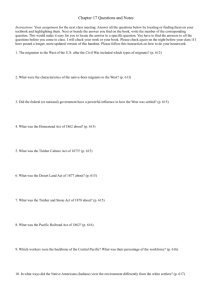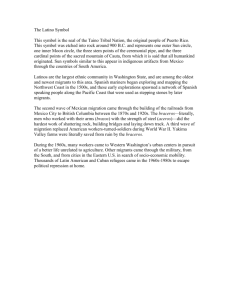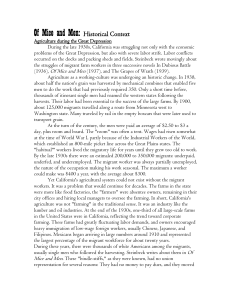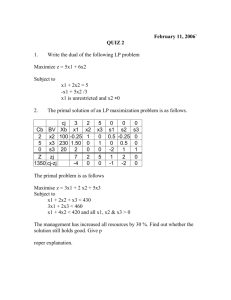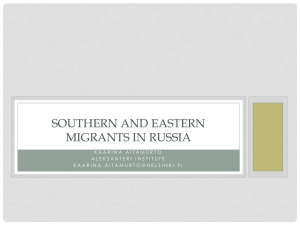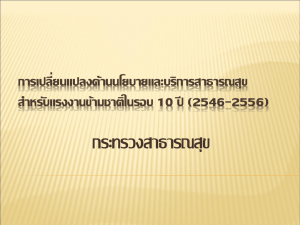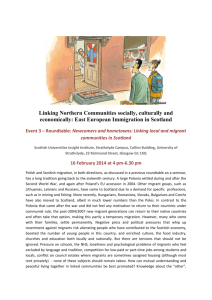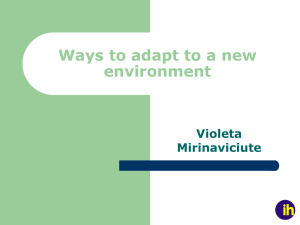3x1_2012_ve
advertisement
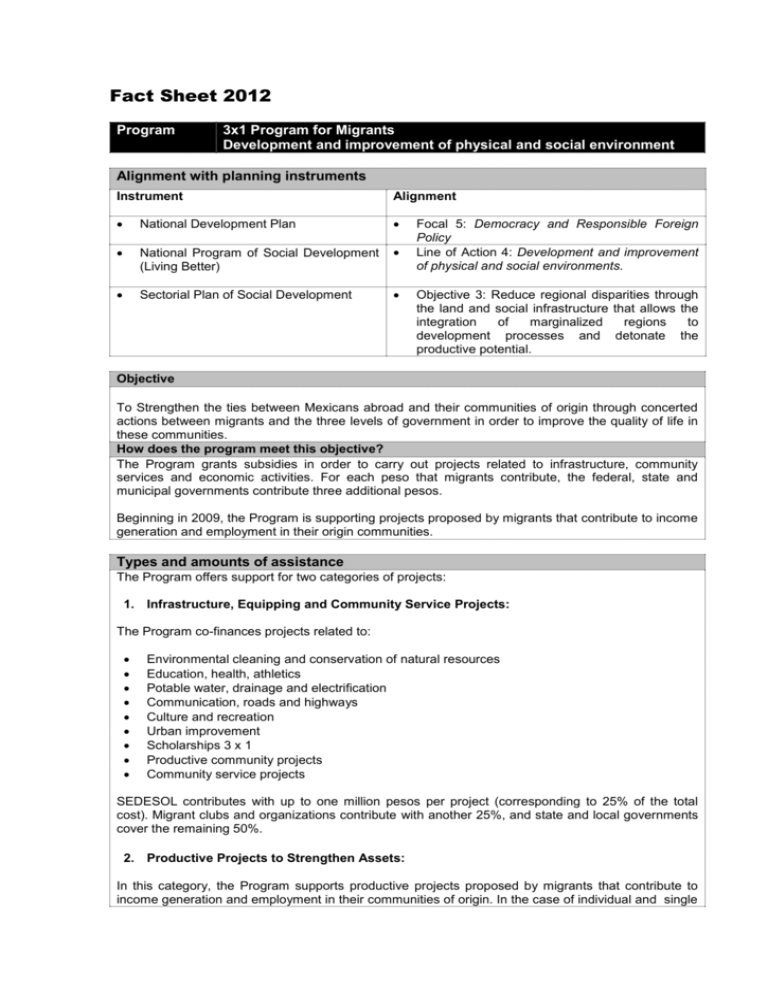
Fact Sheet 2012 Program 3x1 Program for Migrants Development and improvement of physical and social environment Alignment with planning instruments Instrument Alignment National Development Plan National Program of Social Development (Living Better) Sectorial Plan of Social Development Focal 5: Democracy and Responsible Foreign Policy Line of Action 4: Development and improvement of physical and social environments. Objective 3: Reduce regional disparities through the land and social infrastructure that allows the integration of marginalized regions to development processes and detonate the productive potential. Objective To Strengthen the ties between Mexicans abroad and their communities of origin through concerted actions between migrants and the three levels of government in order to improve the quality of life in these communities. How does the program meet this objective? The Program grants subsidies in order to carry out projects related to infrastructure, community services and economic activities. For each peso that migrants contribute, the federal, state and municipal governments contribute three additional pesos. Beginning in 2009, the Program is supporting projects proposed by migrants that contribute to income generation and employment in their origin communities. Types and amounts of assistance The Program offers support for two categories of projects: 1. Infrastructure, Equipping and Community Service Projects: The Program co-finances projects related to: Environmental cleaning and conservation of natural resources Education, health, athletics Potable water, drainage and electrification Communication, roads and highways Culture and recreation Urban improvement Scholarships 3 x 1 Productive community projects Community service projects SEDESOL contributes with up to one million pesos per project (corresponding to 25% of the total cost). Migrant clubs and organizations contribute with another 25%, and state and local governments cover the remaining 50%. 2. Productive Projects to Strengthen Assets: In this category, the Program supports productive projects proposed by migrants that contribute to income generation and employment in their communities of origin. In the case of individual and single families, SEDESOL contributes with up to 300 thousand pesos, and 500 thousand pesos for a twofamily production projects (corresponding to 50% of the total), while migrants contribute the other 50%. State and municipal governments can make additional contributions. The beneficiaries of these projects must reintegrate the received aid by investing in infrastructure, equipment and community service projects under the framework of the 3x1 Program. Detailed information pertaining to the types and amounts of assistance can be found in point 3.5 of the Program Operating Rules. Who can be a beneficiary? The program is targeted at the population residing communities of origin and localities that migrants are interested in helping and which present conditions of poverty in what has to do with infrastructure, equipment and needs linked to the economic activity. The criteria to receive aid is: Respond to migrants’ initiatives living abroad, integrated in clubs or organizations. Have financial support from migrant clubs or organizations, the Federation, the corresponding states and municipalities. Contribute to solving shortages in basic infrastructure or services and generate sources of employment and income for local residents. Requirements are described in point 3.3 of the Operating Rules of the 3x1 Program. Brief history of the program 3x1 was preceded by earlier programs: The programs 1x1 (Migrants- State) and 2x1 (Migrants-State and Municipality) which have operated mainly in the state of Zacatecas since 1992. In 2001, the Citizen Initiative 3x1 Program was established with the goal of conducting projects that benefit the inhabitants of origin or poor communities through concurrent investments by the three branches of governments and organized citizens. In 2004, the Program changed its name to 3x1 Program for Migrants. Budget and executed projects 2009-2012 Year Spent Budget (millons of current pesos) Number of approved projects 20091 20102 20113 20124 525.2 546.3 545.7 507.7 2,421 2,000 2,522 ND 1 Source: Fourth Trimester Report 2009. Source: Fourth Trimester Report 2010. 2 Source: Fourth Trimester Report 2011. 4 Source: Budget of Federation Expenses 2012. 4 ND Not available 2 Main operating achievements As of December 2009: The Program approved 2,421 projects (51.5% more than those approved in 2007). A total of 1,288 localities were benefited (21.3% higher than the benefit in 2007). The constant growth of migrant investment is evidence of increasing trust in federal, state and municipal governments. The program is internationally recognized as one of the best policies globally and is likely to be emulated in various countries. As of December 2010: The Program approved 2,488 projects from which the following can be highlighted: 874 projects of urbanization and pavement; 571 projects of potable water, drainage, and electrification; 359 projects of education, health and sports; 332 of productive guidance, and 56 of rural roads, etc. At the end of 2011, the Program supported 2522 projects (0.9 percent more than the goal for 2011) and 799 migrant clubs during the year. The 3x1 Program for migrants had, by the third trimester of the year, important elements of coresponsibility by integrating resources of the three levels of government and migrants. The federal resources invested represent the 25 per cent of each work or action. This co-financing scheme allows combining efforts and resources in each project or action taken by the program. In 2011, by the fourth quarter, the Program had investments of states and participant municipalities and as well with resources of migrant clubs, for 1 thousand 097 million of pesos. This financing association is an important element of co-responsibility that allows to enhance the targets and join efforts and resources; likewise, it allows the connection and coordination of the three levels of government and migrant clubs. Source: Fourth Trimester Report 2009, 2010 and 2011. External Evaluations: Main Results Results Source External Evaluation of Consistency and Results 2007, Center of Economic Research and Instruction, A. C. (CIDE) The Program is known for successfully linking migrant clubs and organizations to development in their communities of origin under a framework of shared responsibility not only in terms of financing, but also in the selection of projects and benefiting localities. The evaluation has demonstrated that the number of municipalities covered by the Program has doubled between 2002 and 2009. At the same period, the number of participating states has gone from 20 to 28. The indicators of the Specific Performance Evaluation were positive; in all aspects, the targets set were exceeded. The increasing of migrants’ contributions is closely related to its credibility to the program. The works carried out have led to a positive perception in the population The program's actions are consistent with the guidelines established Specific Performance Evaluation 2009-2010, Colegio de México. Specific Performance Evaluation 2010-2011, Colegio de México. Important Links Program Operating Rules: www.sedesol.gob.mx Programas Sociales Programa 3x1 para Migrantes Reglas de Operación 2011 Register of Beneficiaries: www.sedesol.gob.mx Programas Sociales Programa de 3x1 para Migrantes Padrón de Beneficiarios This Guide only explains the objectives, criteria, rules, requirements and other elements prescribed by the Operating Rules of the program in question; it is an easy reference meant to familiarize society with the basics of the Program. This text does not substitute the Operating Rules created in compliance with the applicable legal orders and rules. For additional information related to the program please consult the program’s Operating Rules. This Program is public, independent of any political party. Its use for any ends other than social development is prohibited.
